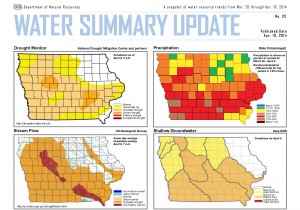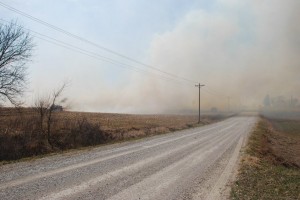CLICK HERE for the latest market quotes from the Iowa Agribusiness Network!
CLICK HERE for the latest market quotes from the Brownfield Ag News Network!
CLICK HERE for the latest market quotes from the Iowa Agribusiness Network!
CLICK HERE for the latest market quotes from the Brownfield Ag News Network!
GUTHRIE CENTER, Iowa (AP) – Environmental specialists with the Iowa Department of Natural Resources are investigating following the crash of ammonia tanks into a western Iowa creek. The department says dead fish were discovered downstream from where two anhydrous ammonia tanks and a tractor fell into Brushy Creek north of Guthrie Center on Friday. The driver of the tractor, 34-year old Michael Haag, of Adair, was transported by Guthrie Center Rescue to the Guthrie County Hospital.
The John Deere 9510R tractor was pulling a disc and the two tanks when an old wooden bridge it was crossing on Oak Avenue, between 200th and 210th Street, collapsed, and the equipment fell into the creek. Investigators determined that the valves of the tanks had been shut off and that there was no fuel leaking from the tractor, but that some ammonia leaked into the water.
Some dead fish and elevated ammonia levels were found as far downstream as Monteith, about five miles southeast of Guthrie Center.
Coordinators of a grant related to local farmers markets are looking for public input. The Cass County Local Food Policy Council received a USDA grant late last year to support and promote farmers markets as access points for local grown food. The grant committee is in the process of holding community meetings to get ideas and suggestions from interested local residents and businesses.
Organizers have already met with groups in Anita and Massena to discuss support for community farmers markets. The Atlantic community meeting is scheduled for Tuesday, April 15th, from 4:30 to 6 PM in the meeting room at the Atlantic Chamber. Anyone interested in supporting or helping with local markets like the “Produce in the Park” project that has happened for the last two summers is welcome to attend to learn more and give their input.
Those who are unable to attend are still welcome to contact organizers LaVon Eblen, Lora Kanning at Cass County Conservation, Teddi Grindberg at the YMCA or Kate Olson at the Cass County Extension Office to share ideas or express interest in being involved with the project.
Warmer temperatures combined with strong winds and dry conditions lead to more brush and wild-land fires across the state. These types of fires can pose a serious threat to lives and property. The National Fire protection Association (NFPA) has reported over 59 million acres have been burned by wildfires in the past decade. While Iowa is not known to have large wildfires like those that regularly affect western states, our state is still prone to dangerous brush fires created by dry conditions, strong winds and low humidity.
To prevent the spread of brush fires and other debris, the Iowa Fire Marshal’s Office suggests keeping in mind:
Check for county burn bans, city restrictions and with the Department of Natural Resources (DNR) Air Quality before conducting any open burning; Never burn on dry and windy days; Have water and tools on hand to extinguish anything that may escape the burn area; Do NOT burn alone, always have another person with you; Do NOT leave a fire unattended; Call 911 immediately if a fire does get out of hand.
And, if you have questions about outdoor fire safety, contact the Iowa Department of Public Safety – State Fire Marshal Division at (515) 725-6145 or e-mail at fminfo@dps.state.ia.us.
COUNTIES: SAC-CRAWFORD-CARROLL-AUDUBON-GUTHRIE-DALLAS-CASS-ADAIR-MADISON-ADAMS-UNION-TAYLOR-RINGGOLD-
1212 PM CDT FRI APR 11 2014
…ELEVATED FIRE DANGER THIS AFTERNOON…
VERY DRY CONDITIONS PREVAIL ACROSS THE AREA AGAIN THIS AFTERNOON…WITH RELATIVE HUMIDITY FALLING TO 15 TO 25 PERCENT IN MANY AREAS. COMBINED WITH GENERALLY WESTERLY WINDS OF AROUND 15 MPH AND GUSTY THIS WILL LEAD TO AN ELEVATED FIRE DANGER UNTIL WINDS SUBSIDE THIS EVENING. ANY OUTDOOR FIRES WILL HAVE THE POTENTIAL TO SPREAD RAPIDLY AND BURNING IS DISCOURAGED.
The weather is starting to get warmer, but and Iowa State University extension crops specialist says farmers should not worry about getting into the fields just yet. Joel DeJong says there’s no hurry to get equipment in the fields. “No I don’t think they need to be overly concerned, it’s still reasonably early. We still have frost a couple feet deep. We need to get that frost out first,” DeJong says.
He says they are starting to see some signs that the frost is starting to go out of the ground. DeJong says trying to get into the fields too early could cause added problems, as the frost traps water in the ground. “Until we get that deeper frost out, I’m a little concerned you might be creating some compaction with some of these tilling tools,” DeJong says. He says the rain in the forecast could help draw some of the frost out of the ground.
DeJong has noticed some farmers applying fertilizer. He says he’s mostly seen farmers putting manure on the fields from feed lots, and he says the ground is “kind of passable” for those applications. The Iowa Agriculture Department reports that farmers in south-central Iowa have been able to get in more time in the fields than other parts of the state.
(Radio Iowa)
The Iowa Department of Natural Resources reports overall, dry conditions persist for most of Iowa. In their latest Water Summary Update, the DNR says precipitation average for the past two weeks has been 0.76 inch — a half inch less than normal. The continuing drought is reflected in the change of stream flows across the majority of the state. The lowest conditions are in the Raccoon and Des Moines river basins, which have less than 10 percent of normal stream flow.
In their latest Water Summary Update, the DNR says precipitation average for the past two weeks has been 0.76 inch — a half inch less than normal. The continuing drought is reflected in the change of stream flows across the majority of the state. The lowest conditions are in the Raccoon and Des Moines river basins, which have less than 10 percent of normal stream flow.
Shallow groundwater levels are lower in southwest, west central and south central Iowa. Adequate spring rainfall will be critical to recharge the alluvial and shallow bedrock aquifers. Conditions are close to normal for northeast Iowa, which had near normal rainfall during the past two weeks.
For a more thorough review of Iowa’s water resource trends March 27 through April 9, go to http://www.iowadnr.gov/watersummaryupdate.
WEST FARGO, N.D. (AP) – Titan Machinery says it is closing eight construction stores across the country, including two locations in Iowa. The company based in West Fargo, North Dakota on Thursday cited a slow recovery in construction sector among the reasons for the move, which will leave 128 people unemployed. The stores being closed are located in Clear Lake and Oskaloosa, Iowa; Cheyenne, Wyoming; Flagstaff, Arizona; Rosemount, Minnesota; and Helena, Bozeman, and Big Sky, Montana. All locations will cease operations by the end of April.
The company sells and rents agriculture and construction equipment. CEO David Meyer says the decision will help the company improve its pre-tax profits. The company says affected employees will receive benefits and severance package and the option to apply for jobs at nearby stores. Titan Machinery will continue to operate 96 stores in the U.S.
AREA COUNTIES: SAC-CRAWFORD-CARROLL-AUDUBON-GUTHRIE-DALLAS-CASS-ADAIR-MADISON-ADAMS-UNION-TAYLOR
1049 AM CDT THU APR 10 2014
…ELEVATED FIRE DANGER ACROSS MUCH OF CENTRAL IOWA TODAY…
NORTHWEST WINDS WILL INCREASE FURTHER AND BECOME GUSTY BY THIS
AFTERNOON…ALONG WITH RELATIVE HUMIDITY FALLING INTO THE 20S.
THIS COMBINATION OF WIND AND LOW RELATIVE HUMIDITY WILL PRODUCE
AN ELEVATED FIRE DANGER TODAY. THE MOST FAVORABLE CONDITIONS WILL
EXIST DURING THE AFTERNOON. WINDS WILL DIE OFF QUICKLY THIS
EVENING WITH RAPIDLY IMPROVING FIRE CONDITIONS.
Firefighters in Montgomery County had a very busy day, Wednesday. Emergency Management Coordinator Brian Hamman reports firefighters from Stanton were finishing up with a previous field fire at around 2-p.m., when they noticed heavy smoke south of Stanton. A crew from Stanton responded to investigate the area and found a large fire in a field in the area of 110th Street and M Avenue, in Page County.
 Fire crews from Essex, Red Oak, and Villisca assisted on the scene for several hours. Multiple tractors with discs also aided with controlling the fire. While this was ongoing, a rekindle of a previous fire west of Stanton occurred and a second crew from Red Oak and Stanton were able to control the fire in a short amount of time. The cause of this fire appears to have been from previous burn pile that was reignited by strong winds.
Fire crews from Essex, Red Oak, and Villisca assisted on the scene for several hours. Multiple tractors with discs also aided with controlling the fire. While this was ongoing, a rekindle of a previous fire west of Stanton occurred and a second crew from Red Oak and Stanton were able to control the fire in a short amount of time. The cause of this fire appears to have been from previous burn pile that was reignited by strong winds.
Earlier in the day, the Villisca Fire Department was paged to a small waterway on fire around 8:30-a.m., and another fire around 11-a.m., in Villisca. Stanton was paged almost simultaneously to two separate field/ditch fires around 11:30-a.m. The first was a half mile south of Stanton on O Ave and the second fire was west of Stanton on the train tracks around 220th Street and M Ave. Fire crews from Red Oak and Villisca Fire assisted Stanton Fire on both fires, using with grass trucks and tankers.
Although most of fires were unintentionally set, some were from old burns that had taken place or others were set and left. Red Flag conditions were in effect Wednesday. When that type of warning is in-place, no one should conduct any outdoor burning, at any time.
There were also reports of field fires in Shelby County, and near the Lake Anita Dam in Cass County, Wednesday afternoon.